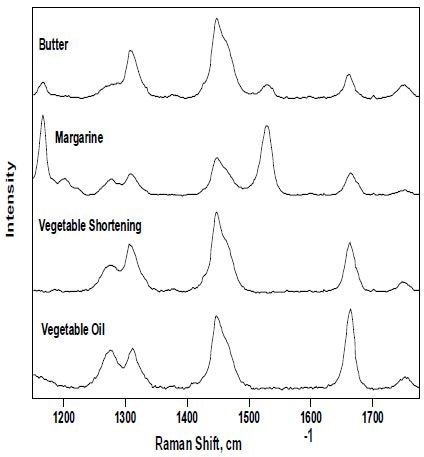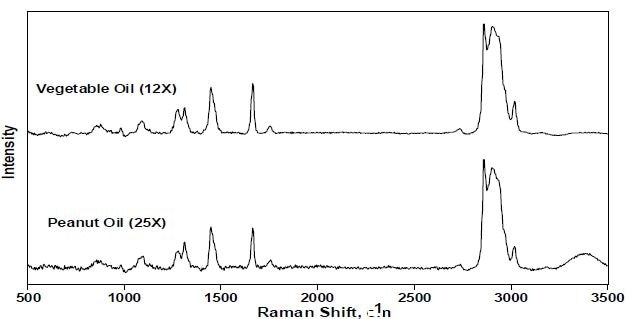In today's foods industry, it is very important to know the level of unsaturation and the relative amounts of cis and trans isomer content in edible oils and fats This is imperative in terms of process as well as quality control, and represents the necessary nutritional data in food labeling.
Total unsaturation of oils and fats is represented as the Iodine Value (IV), which is presently measured through standard titration techniques. Techniques like FTIR are used to measure trans isomer content, while gas chromatography (GC) is used to determine the composition of lipid fatty acids. Conversely, these methods are not suitable for on-line process control due to chromatographic time limitations, infrared (IR) absorption by water, and rigorous sampling needs.
Raman spectroscopy is considered to be a suitable method to make on-line determination of total unsaturation and cis/trans isomer content in oils and fats in a fast and accurate way. With the help of FT-Raman, an off-line demonstration of this analysis has emerged. This article provides proof that such an analysis can be easily performed using dispersive Raman instruments meant for process control.
Experimental Procedure
A fully incorporated, remote Kaiser Optical Systems HoloProbe™ analyzer, equipped with 10 mW of 532 nm incident laser light, was used to obtain the data. The entire Raman spectrum was obtained in a single exposure by means of a HoloPlex™ grating, and enabled quantitative analysis across the whole quantified range. Based on the sample, integration times spanned between 60 and 300 seconds.
Determination of Total Unsaturation
The Raman spectra of vegetable oil, margarine, butter, and vegetable shortening from 1150 to 1775 cm–1 are shown in Figure 1.

Figure 1. Background-corrected Raman spectra of commercial food oils and fats. The bands at 1165 and 1525 cm–1 of the butter and margarine spectra are attributed to the coloring agent β- carotene.
Quantitative determination of total unsaturation can be achieved by estimating the ratio of the C=C stretch (νC=C) focused at 1661 cm–1 to the CH2 scissoring deformation (δCH2) at 1444 cm–1. When the relative intensities of δCH2 and νC=C were compared, it was observed that butter had the maximum percentage of saturated fat. However, vegetable oil was found to have the least saturation, while margarine and vegetable shortening come between these two extremes. This corresponds with what is qualitatively known beforehand. Vegetable shortenings and vegetable oils are better than animal shortenings in terms of nutritional viewpoint because they have less saturated fat.
Cis Isomer Content
The Raman spectrum can also be utilized to measure the Cis isomer content. At 1272 cm–1, the band is the result of in-plane =C–H deformation in a unconjugated cis double bond. The cis isomer content can be directly measured by the intensity of this band ratioed to the in-phase methylene twisting vibration at 1306 cm–1.
This is clearly shown by making a comparison between the Raman spectrum of vegetable oil and the partly hydrogenated vegetable shortening. Hydrogenation leads to a preferential decrease in the cis/trans isomer ratio. In Figure 1, it is seen that unhydrogenated vegetable oil has considerably more cis isomer character as opposed to the partly hydrogenated vegetable shortening.
Background Correction in Highly Fluorescent Samples
The background-corrected, full Raman spectra of peanut and vegetable oils are shown in Figure 2. The background level ratio to the δCH2 vibration intensity emerges in parentheses by individual spectra.

Figure 2. Background-corrected spectra of vegetable and peanut oils.
In commercial samples, fluorescence is clearly seen which is due to the assorted coloring agents. Figure 2 show that despite the existence of considerable background, Raman spectra acquired from these sample groups can be viewed instantly. Dispersive Raman with perceptible excitation provides clear benefits over FT-Raman, particularly in those situations where fluorescence is not overpowering. Sensitivity is further improved, thanks to the highly efficient CCD detector and ν Raman intensity dependence. Alternatively, a longer incident wavelength can be used to reduce or prevent fluorescence. A RamanRxn1™ analyzer fitted with a 785 nm NIR laser is ideal for this application.
Conclusion
The RamanRxn1 analyzer provides high throughput and makes it possible to use short exposure times and low laser powers to perform remote Raman measurements. The analyzer is compact, has a robust design, and has minimal utility requirements, which make it suitable for applications beyond lab environments. Raman spectroscopy can be used for the online determination of cis isomer content and total unsaturation in commercial samples of fats and oils.

This information has been sourced, reviewed and adapted from materials provided by Kaiser Optical Systems, Inc.
For more information on this source, please visit Kaiser Optical Systems, Inc.